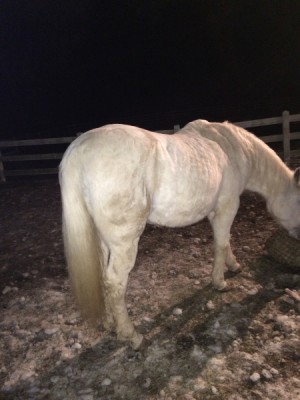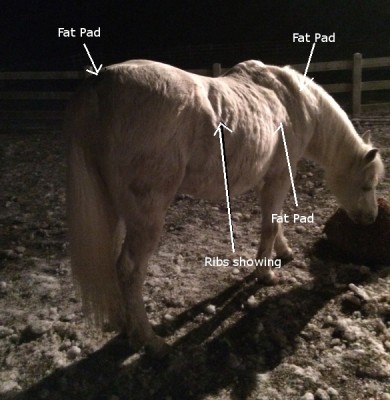Meet Thalia CF 1992gm, Davenport, A Rehabilitation Project
Meet Thalia CF, a 23yo 100% Davenport mare of very old lines whom Edouard stepped up to give a home to and also hopes to get a foal from in the future. He officially became her owner when I recently picked her up in Virginia and brought her to my place for “rehabilitation”.
All Edouard and I knew about the mare aside from her pedigree, before picking her up, was her age and that she’d had laminitis (founder) in the early fall of 2015. We had seen a couple of pictures of her taken by friends who visited the farm where she lived with her then owner. They had noted Thalia, at that time, resting in a laminitic stance. This resting stance is recognized by the front legs being extended out in front of the body to take weight off the toes, and the hind legs camped under the body to support the weight of the body. This was in mid-October 2015.
Thalia had recovered from that laminitic episode enough to be safely trailered by the time I picked her up on December 28, 2015.
What I saw when she was led out to the trailer, for her trip to my place, was a mare showing classic symptoms of PPID (pituitary pars intermedia dysfunction) also known as Cushing’s Disease. To learn about the symtomatic presentation of this condition visit the link: http://ecirhorse.org/index.php/cushing-s-disease
What is PPID?
“ PPID = pituitary pars intermedia dysfunction = Cushing’s Disease. It is caused by loss of neurons in the brain, originating in the hypothalamus, that send nerve endings down to the pituitary where they release dopamine. Dopamine inhibits/controls the release of the hormones that are elevated in PPID.”(1)
Thalia has a very long, thick coat despite living in a mid-Atlantic state. She has a “beginning to sag” belly, and she has fat pads all over her body even though her ribs are visible through that thick heavy coat. So not only is she presenting as PPID she is also presenting as IR (Insulin Resistant) which is why she has the fat pads.
What is IR?
“Insulin Resistance (IR) is characterized by a loss of insulin sensitivity at the cellular level. The insulin resistant horse is carbohydrate intolerant and the degree of insulin resistance can be assessed and measured as part of the diagnosis and recovery process.”(2)
Photographing white horses in an attempt to show everything one can see with their eyes is difficult. Which is why there were no obvious clues about her issues from the October pictures.
This is Thalia photographed using the flash on Jan 3, 2016 around 7:00pm.
I can see her ribs outlined in her coat, the fat pads on her shoulders and her neck, harder to see the fat pads on her hindquarters.
Now without the flash.
I’ve only noted a very “few” of the fat pads she actually has. In this next photo I’m pinching the fat pad on her neck in front of her withers.
The gold standard for diagnosing PPID and IR is blood work. The ACTH blood test is used for diagnosing PPID and a glucose and insulin measurement from a separate single draw of blood is used for diagnosing IR. These tests will be done, depending upon how she responds to diet changes over the next two months, when the vet is out in late February to sedate Elegance for her next dental visit.
I found out from her previous owner that he did not believe in vaccinations or in chemical wormers. He did feed diatomaceous earth to try and control parasites. However there is no scientific evidence this is effective.
It is possible that Thalia’s “unthrifty” condition, extended belly, ribby appearance and overt-thick coat is due to worm overload. She will be wormed using the rescue horse worming protocol of 3 – once a month doses of ivermectin with one of those 3 doses containing praziquantel for tape worm. I want to give her a couple of weeks to settle in before beginning the worming protocol.
While she may not have PPID I am sure she will test positive for IR.
(1) ecirhorse.org
(2) ecirhorse.org




Lest you think I am doing nothing to help this mare with her metabolic issues while we wait for blood work, rest assured that she is being fed a low ( < 10%) starch + sugar diet and is also receiving the herb Chaste Berry Tree powder. Chaste Berry Tree (vitex angus-castas) is known to have a positive affect on the hormonal system and is often a first line of defense when PPID is suspected before the blood work can be obtained. The low starch+sugar diet is what helps bring the Insulin Resistant issues she has under control